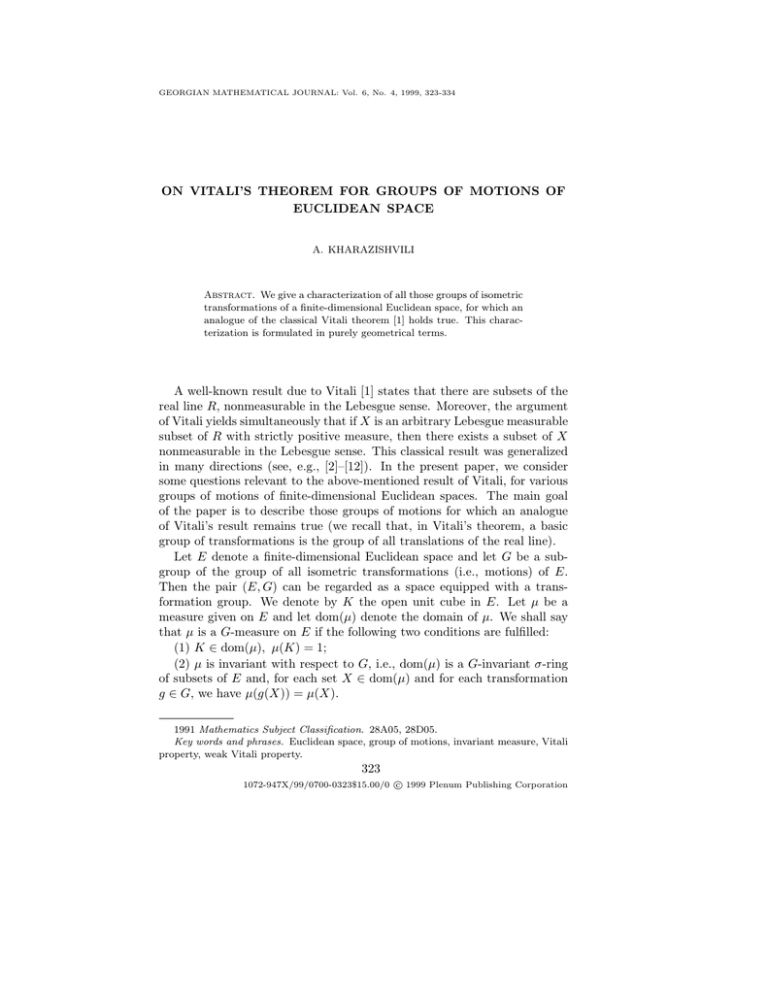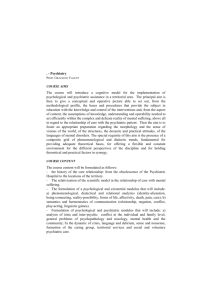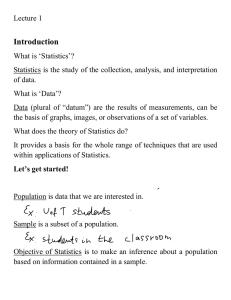ON VITALI’S THEOREM FOR GROUPS OF MOTIONS OF EUCLIDEAN SPACE
advertisement

GEORGIAN MATHEMATICAL JOURNAL: Vol. 6, No. 4, 1999, 323-334
ON VITALI’S THEOREM FOR GROUPS OF MOTIONS OF
EUCLIDEAN SPACE
A. KHARAZISHVILI
Abstract. We give a characterization of all those groups of isometric
transformations of a finite-dimensional Euclidean space, for which an
analogue of the classical Vitali theorem [1] holds true. This characterization is formulated in purely geometrical terms.
A well-known result due to Vitali [1] states that there are subsets of the
real line R, nonmeasurable in the Lebesgue sense. Moreover, the argument
of Vitali yields simultaneously that if X is an arbitrary Lebesgue measurable
subset of R with strictly positive measure, then there exists a subset of X
nonmeasurable in the Lebesgue sense. This classical result was generalized
in many directions (see, e.g., [2]–[12]). In the present paper, we consider
some questions relevant to the above-mentioned result of Vitali, for various
groups of motions of finite-dimensional Euclidean spaces. The main goal
of the paper is to describe those groups of motions for which an analogue
of Vitali’s result remains true (we recall that, in Vitali’s theorem, a basic
group of transformations is the group of all translations of the real line).
Let E denote a finite-dimensional Euclidean space and let G be a subgroup of the group of all isometric transformations (i.e., motions) of E.
Then the pair (E, G) can be regarded as a space equipped with a transformation group. We denote by K the open unit cube in E. Let µ be a
measure given on E and let dom(µ) denote the domain of µ. We shall say
that µ is a G-measure on E if the following two conditions are fulfilled:
(1) K ∈ dom(µ), µ(K) = 1;
(2) µ is invariant with respect to G, i.e., dom(µ) is a G-invariant σ-ring
of subsets of E and, for each set X ∈ dom(µ) and for each transformation
g ∈ G, we have µ(g(X)) = µ(X).
1991 Mathematics Subject Classification. 28A05, 28D05.
Key words and phrases. Euclidean space, group of motions, invariant measure, Vitali
property, weak Vitali property.
323
c 1999 Plenum Publishing Corporation
1072-947X/99/0700-0323$15.00/0
324
A. KHARAZISHVILI
For example, the standard Lebesgue measure on E (considered as a Ginvariant measure) is a G-measure on E.
We say that a group G has the Vitali property if, for every G-measure µ
on E and for each µ-measurable set X ⊂ E with µ(X) > 0, there exists at
least one µ-nonmeasurable subset of X.
We say that a group G has the weak Vitali property if, for every Gmeasure µ on E, there exists at least one µ-nonmeasurable subset of E.
We are going to establish some necessary and sufficient conditions (formulated in terms of the pair (E, G)) under which a given group G has the
Vitali property (the weak Vitali property, respectively).
First we wish to recall some auxiliary notions and facts.
Let F be a nonempty basic set and let Γ be a group of transformations
of F . We recall that Γ acts freely on F if, for each point x ∈ F and for any
two distinct transformations g ∈ Γ and h ∈ Γ, the relation g(x) 6= h(x) is
fulfilled.
In particular, the group of all translations of Euclidean space E acts
freely on E.
We denote by ω the least infinite ordinal (cardinal) number and by c the
cardinality continuum.
For any set X, the symbol card(X) denotes the cardinality of X.
IdE is the identity transformation of a space E.
λ is the standard Lebesgue measure on a space E (note that the dimension
of λ coincides with the dimension of E).
If L is an affine linear manifold in a space E, then dim(L) denotes the
dimension of L.
If µ is an arbitrary measure on a space E, then µ∗ and µ∗ denote, respectively, the outer measure and the inner measure associated with µ.
Now, let us formulate several statements which we need in our further
considerations.
Lemma 1. Let E be an n-dimensional Euclidean space, G be a group of
affine transformations of E with card(G) < c, and let Y be a subset of E
such that
(1) card(Y ) = c;
(2) any n + 1 pairwise distinct points of Y do not belong to an affine
hyperplane of E (in other words, Y is a set of points in general position).
Then there exists a point y ∈ Y for which the group G acts freely on the
G-orbit G(y).
The proof of this lemma is not difficult. Actually, it follows from the
fact that every affine transformation of E is completely determined by its
restriction to a subset of Y with cardinality n + 1.
ON VITALI’S THEOREM
325
Lemma 1 implies a number of useful consequences. For example, one of
such consequences is the next well-known statement.
Lemma 2. Let G be a group of isometric transformations of a finitedimensional Euclidean space E. Then the following two conditions are
equivalent:
(1) G is discrete;
(2) for each point e ∈ K, the set G(e) is locally finite in E.
Lemma 3. Let E be a finite-dimensional Euclidean space, G be a group
of motions of E and K denote the open unit cube in E. Then the following
three assertions are equivalent:
(1) ∪{g(K) : g ∈ G} = E;
(2) for every G-measure µ on E and for each bounded µ-measurable set
X ⊂ E, we have µ(X) < +∞;
(3) for every G-measure µ on E and for each µ-measurable set X ⊂ E
with µ(X) > 0, there exists a µ-measurable set Y ⊂ X such that 0 < µ(Y ) <
+∞.
Proof. Suppose that assertion (1) is true. Let µ be an arbitrary G-measure
on E and let X be an arbitrary bounded µ-measurable subset of E. Let
cl(X) denote the closure of X. Obviously, the set cl(X) is compact and the
family {g(K) : g ∈ G} forms an open covering of cl(X). Consequently,
there exists a finite subset H of G such that
X ⊂ cl(X) ⊂ ∪{h(K) : h ∈ H}.
Hence we have
µ(X) ≤ µ(∪{h(K) : h ∈ H}) ≤ card(H) < +∞
and thus assertion (2) is fulfilled.
Suppose again that assertion (1) is true and let X be an arbitrary µmeasurable subset of E with µ(X) > 0. Clearly, we can write
E = ∪{h(K) : h ∈ H},
for some countable subset H of G. The latter equality yields
X
µ(h(K) ∩ X).
0 < µ(X) = µ(∪{h(K) ∩ X : h ∈ H}) ≤
h∈H
Consequently there exists an element h ∈ H such that µ(h(K) ∩ X) > 0.
Let us put Y = h(K) ∩ X. Then we get
0 < µ(Y ) ≤ µ(h(K)) = µ(K) = 1
and hence assertion (3) is fulfilled. In this way we have obtained the implications (1) ⇒ (2) and (1) ⇒ (3).
326
A. KHARAZISHVILI
Finally, suppose that assertion (1) is not true. Then there is a point
z ∈ E satisfying the relation
G(z) ∩ (∪{g(K) : g ∈ G}) = ∅.
Let us put Z = ∪{g(K) : g ∈ G} and consider the family of sets
S = {Z 0 ∪ Z 00 : Z 0 ⊂ Z, Z 0 ∈ dom(λ), Z 00 ⊂ G(z)}.
It can easily be checked that S is a G-invariant σ-ring of subsets of E
and K ∈ S. Now we define a functional ν on S in the following manner:
ν(Z 0 ∪ Z 00 ) = λ(Z 0 ) if Z 00 = ∅, and ν(Z 0 ∪ Z 00 ) = +∞ if Z 00 6= ∅. Then it
is not difficult to see that this functional is a G-measure on E. Moreover,
the one-element ν-measurable set {z} with ν({z}) = +∞ shows directly
that the assertions (2) and (3) are false for ν. Thus we have established the
implications (2) ⇒ (1) and (3) ⇒ (1).
Lemma 4. Let G be a group of motions of a finite-dimensional Euclidean space. Then the following two assertions are equivalent:
(1) for any point e ∈ K, the G-orbit G(e) is not a locally finite subset
of E;
(2) for every G-measure µ on E and for each point e ∈ K, we have
{e} ∈ dom(µ) ⇒ µ({e}) = 0.
Proof. (1) ⇒ (2). Suppose that assertion (1) is true. Let e be an arbitrary
point of K and let µ be a G-measure on E such that {e} ∈ dom(µ). It is
not difficult to deduce from assertion (1) that
card(G(e) ∩ K) ≥ ω.
If µ({e}) > 0, then (taking into account the G-invariance of µ) we immediately obtain that µ(K) = +∞, which is impossible. Consequently
µ({e}) = 0 and the implication (1) ⇒ (2) has been established.
(2) ⇒ (1). Suppose that assertion (2) is true. Let e ∈ K. We must show
that the orbit G(e) is not locally finite in E. Assuming to the contrary that
G(e) is a locally finite subset of E, it is easy to define a G-measure ν on E
such that
{e} ∈ dom(ν), ν({e}) > 0.
Indeed, we have the inequalities
0 < card(G(e) ∩ K) < ω.
Let us denote p = card(G(e) ∩ K). Further, for each subset X of E, let us
put ν(X) = (1/p) card(X ∩ G(e)) if card(X ∩ G(e)) < ω and ν(X) = +∞
if card(X ∩ G(e)) = ω. Then ν is the required G-measure (defined on
the family of all subsets of E). Thus we have established the implication
(2) ⇒ (1) and the proof of Lemma 4 is complete.
ON VITALI’S THEOREM
327
Lemma 5. Let E be a finite-dimensional Euclidean space, e be a point of
E and let L be an affine linear manifold in E containing e. Let {hm : m <
ω} be a countable family of motions of E, satisfying the relations:
(1) the family of points {hm (e) : m < ω} is injective and
lim
m→+∞
hm (e) = e;
(2) the family of manifolds {hm (L) : m < ω} is finite.
Denote by H the group of motions, generated by {hm : m < ω}. Then
there exists a countable family {gn : n < ω} ⊂ H such that:
(a) gn (L) = L for all n < ω;
(b) {gn : n < ω} is convergent to some motion of E;
(c) the family {gn |L : n < ω} is injective, where the symbol gn |L
denotes, for each n < ω, the restriction of gn to L.
We omit an easy purely geometrical proof of Lemma 5.
Now we can formulate and prove
Theorem 1. Let G be a group of motions of a finite-dimensional Euclidean space E. Then G has the Vitali property if and only if the following
two conditions are fulfilled:
(1) for any point e ∈ K, the G-orbit G(e) is not locally finite in E;
(2) ∪{g(K) : g ∈ G} = E.
Proof. Suppose that assertions (1) and (2) are satisfied and let us show that
G has the Vitali property. Let µ be an arbitrary G-measure on E and let
X be an arbitrary µ-measurable subset of E with µ(X) > 0. We must find
a µ-nonmeasurable subset of X. Taking into account Lemma 3, we may
assume that X is a subset of K. Denote by r = r(X) the least natural
number such that there exists an affine linear manifold L ⊂ E for which
dim(L) = r and µ∗ (L ∩ X) > 0. According to Lemma 4 we can assert that
r = dim(L) > 0.
Consider the set T = L ∩ X. If this set is nonmeasurable with respect to
µ, then there is nothing to prove. So we may assume that T ∈ dom(µ) and
hence µ(T ) > 0. Fix a point t ∈ T . Applying condition (1) to t, we see that
the orbit G(t) is not locally finite in E. It can easily be deduced from this
fact that there exists a countable family {hm : m < ω} ⊂ G such that the
corresponding family of points {hm (t) : m < ω} is injective and
lim
m→+∞
hm (t) = t.
We may also assume, without loss of generality, that {hm
converges to some motion of E.
:
m < ω}
328
A. KHARAZISHVILI
Now, consider the family of affine linear manifolds
{hm (L) : m < ω}.
Only two cases are possible.
1. This family is infinite. In this case we may suppose without loss of
generality that
6 hn (L)).
(∀m < ω)(∀n < ω)(m =
6 n ⇒ hm (L) =
In particular, if m 6= n, we have
dim(hm (L) ∩ hn (L)) < dim(L).
Recalling the definition of the natural number r, we easily deduce that
µ(hm (T ) ∩ hn (T )) = 0 (m < ω, n < ω, m =
6 n).
It immediately follows from the latter fact that
µ(∪{hm (T ) : m < ω}) = +∞
because µ(T ) > 0 and the countable family {hm (T ) : m < ω} is almost
disjoint with respect to µ. On the other hand, since the sequence {hm : m <
ω} converges to some motion of E and the set T is bounded in E, the µmeasurable set
∪{hm (T ) : m < ω}
is bounded in E, too, and according to Lemma 3 the inequality
µ(∪{hm (T ) : m < ω}) < +∞
must be true. Thus we have obtained a contradiction which shows us that
case 1 is impossible.
2. The family {hm (L) : m < ω} is finite. In this case, applying Lemma
5, we see that there exists a countable family {gn : n < ω} ⊂ G satisfying
the following relations:
(a) gn (L) = L for all n < ω;
(b) {gn : n < ω} converges to some motion of E;
(c) the family {gn |L : n < ω} is injective.
Further, denote by G0 the subgroup of G generated by {gn : n < ω}.
Obviously,
(∀g ∈ G0 )(g(L) = L).
Let {Zi : i ∈ I} denote the family of all those G0 -orbits in L which have a
nonempty intersection with the set T . Let Y be a selector of the family of
nonempty sets
{Zi ∩ T : i ∈ I}.
ON VITALI’S THEOREM
329
We are going to show that Y is nonmeasurable with respect to µ. Suppose
otherwise, i.e., that Y ∈ dom(µ). Then, taking into account the relations
µ(T ) > 0, T ⊂ ∪{g(Y ) : g ∈ G0 }
and the countability of the group G0 , we obtain that µ(Y ) > 0. It is not
difficult to check that, for any two distinct natural numbers n and m, the set
gn (Y ) ∩ gm (Y ) lies in an affine linear manifold whose dimension is strictly
less than r = dim(L). According to the definition of r we have
µ(gn (Y ) ∩ gm (Y )) = 0 (n < ω, m < ω, n 6= m).
Finally, let us consider the set
∪{gn (Y ) : n < ω}.
This set is µ-measurable and bounded in E. Applying Lemma 3, we get
µ(∪{gn (Y ) : n < ω}) < +∞.
On the other hand, as mentioned above, the family {gn (Y ) : n < ω} is
almost disjoint with respect to µ and µ(Y ) > 0. Consequently,
µ(∪{gn (Y ) : n < ω}) = +∞.
Thus we have obtained a contradiction which shows us that the Vitali property follows from the conjunction of conditions (1) and (2).
It remains to establish that if at least one of conditions (1) and (2) is not
fulfilled, then our group G does not have the Vitali property.
Suppose first that condition (1) does not hold for G. Then there exists a
point e of K for which the orbit G(e) is a locally finite subset of E. Hence
0 < card(K ∩ G(e)) < ω. Let p = card(K ∩ G(e)). For each set X ⊂ E, we
put ν(X) = (1/p) card(X ∩ G(e)) if card(X ∩ G(e)) < ω, and ν(X) = +∞
if card(X ∩ G(e)) = ω. Then it is easy to see that the functional ν is a
G-measure defined on the family of all subsets of E. Consequently G does
not possess the Vitali property.
Suppose now that ∪{g(K) : g ∈ G} 6= E and let z be an arbitrary point
from the set E \ ∪{g(K) : g ∈ G}. Then
G(z) ∩ (∪{g(K) : g ∈ G}) = ∅.
As in the proof of Lemma 3, we denote Z = ∪{g(K) : g ∈ G} and
S = {Z 0 ∪ Z 00 : Z 0 ⊂ Z, Z 0 ∈ dom(λ), Z 00 ⊂ G(z)}.
Further, we define a functional ν on S in the same manner as in the proof of
Lemma 3. Namely, we put ν(Z 0 ∪ Z 00 ) = λ(Z 0 ) if Z 00 = ∅ and ν(Z 0 ∪ Z 00 ) =
6 ∅. Then ν is a G-measure on E such that the set {z} is ν+∞ if Z 00 =
measurable, ν({z}) > 0 and {z} does not contain ν-nonmeasurable subsets.
Consequently the group G does not possess the Vitali property.
330
A. KHARAZISHVILI
Slightly changing an argument presented above, we can also give a characterization of those groups of motions of a finite-dimensional Euclidean
space, which have the weak Vitali property.
Theorem 2. Let G be a subgroup of the group of all isometric transformations of a finite-dimensional Euclidean space E. Then the following two
conditions are equivalent:
(1) for each point e ∈ K, the orbit G(e) is not locally finite in E;
(2) G possesses the weak Vitali property.
Proof. It suffices to establish only the implication (1) ⇒ (2). Suppose that
condition (1) is fulfilled and let µ be an arbitrary G-measure on E. We
are going to show that the cube K contains a subset nonmeasurable with
respect to µ. Denote by r = r(µ) the least natural number such that there
exists an affine linear manifold L in E for which we have dim(L) = r and
µ∗ (L ∩ K) > 0. Let us put T = L ∩ K. If T is nonmeasurable with respect
to µ, then there is nothing to prove. So we can suppose that T ∈ dom(µ)
and, hence, µ(T ) > 0. Fix a point t ∈ T . According to (1), the orbit G(t) is
not locally finite in E. It follows from this fact that there exists a countable
family {hm : m < ω} of elements of G, satisfying the relations:
(a) the family of points {hm (t) : m < ω} is injective;
(b) lim hm (t) = t;
m→+∞
(c) {hm : m < ω} converges to some motion of E.
We may assume, without loss of generality, that {hm : m < ω} converges
−1
: m < ω} converges to IdE , too. Since K
to IdE . Then the family {hm
is an open subset of E, we can write
K ⊂ ∪{∩{h−1
m (K) : n < m < ω} : n < ω}.
Consequently there exists a natural number m0 such that
µ(T ∩ (∩{h−1
m (K) : m0 < m < ω})) > 0.
Let us denote
−1
(K) : m0 < m < ω}).
Z = T ∩ (∩{hm
Then, for each integer m > m0 , we have hm (Z) ⊂ K and, therefore,
∪{hm (Z) : m0 < m < ω} ⊂ K, µ(∪{hm (Z) : m0 < m < ω}) ≤ 1.
Consider now the family of affine linear manifolds {hm (L) : m0 < m < ω}
and suppose, for a while, that this family is infinite. Then we may assume
that
hm (L) 6= hn (L) (m0 < m < ω, m0 < n < ω, m 6= n).
Recalling the definition of r = dim(L), we obtain
µ(hm (Z) ∩ hn (Z)) = 0
ON VITALI’S THEOREM
331
for any two distinct integers m > m0 and n > m0 (because the set hm (Z) ∩
hn (Z) lies in an affine linear manifold whose dimension is strictly less than
r). Hence we get the equality
µ(∪{hm (Z) : m0 < m < ω}) = +∞,
which yields a contradiction. Thus the family {hm (L) : m0 < m < ω} is
finite.
Further, applying Lemma 5, we can find a countable family {gn : n <
ω} ⊂ G satisfying the relations:
(a) gn (L) = L for all n < ω;
(b) {gn : n < ω} converges to some motion of E;
(c) the family {gn |L : n < ω} is injective.
We may also assume, without loss of generality, that {gn : n < ω}
converges to IdE . Now, since T is an open subset of L and {gn−1 : n < ω}
converges to IdE , we can write
T ⊂ ∪{∩{gn−1 (T ) : m < n < ω} : m < ω}.
Consequently there exists a natural number n0 such that
µ((∩{gn−1 (T ) : n0 < n < ω}) ∩ T ) > 0.
Let us put
T 0 = (∩{gn−1 (T ) : n0 < n < ω}) ∩ T
and let G0 denote the subgroup of G generated by the family {gn : n0 <
n < ω}. Obviously,
(∀g ∈ G0 )(g(L) = L).
Further, let {Zi : i ∈ I} be the family of all those G0 -orbits in L which
have a nonempty intersection with T 0 . Let Y be a selector of the family
{Zi ∩ T 0 : i ∈ I}. We assert that Y does not belong to dom(µ). Suppose
otherwise: Y ∈ dom(µ). Then, taking into account the inclusion
T 0 ⊂ ∪{g(Y ) : g ∈ G0 }
and the inequality µ(T 0 ) > 0, we get µ(Y ) > 0. On the other hand, for any
two distinct natural numbers n and m, we have the equality
µ(gn (Y ) ∩ gm (Y )) = 0
because the set gn (Y )∩gm (Y ) lies in an affine linear manifold whose dimension is strictly less than r = dim(L). In particular, the family {gn (Y ) : n0 <
n < ω} is almost disjoint with respect to µ and, hence,
µ(∪{gn (Y ) : n0 < n < ω}) = +∞.
But, for each integer n > n0 , we can write
gn (Y ) ⊂ gn (T 0 ) ⊂ T ⊂ K
332
A. KHARAZISHVILI
and consequently
∪{gn (Y ) : n0 < n < ω} ⊂ K, µ(∪{gn (Y ) : n0 < n < ω}) ≤ 1.
Thus we have obtained a contradiction which shows us that the set Y does
not belong to dom(µ).
We wish to finish the paper with some remarks concerning the results
presented above.
Remark 1. Let (F, Γ) be a space equipped with a transformation group
and let µ be a σ-finite Γ-invariant measure on F . We say that the group Γ
acts freely on F with respect to µ if, for any two distinct transformations g
and h from Γ, we have
µ∗ ({x ∈ F : g(x) = h(x)}) = 0.
For example, the group of all motions of a finite-dimensional Euclidean
space E acts freely on E with respect to the Lebesgue measure λ.
Some generalizations of the Vitali classical theorem were discussed for
various groups of transformations acting freely with respect to a given
nonzero σ-finite invariant measure (see, e.g., [10] and [11]). The freeness
of a group of transformations with respect to a given invariant measure
seems to be rather natural. However we want to point out that, even in
the case of two-dimensional Euclidean space E, an example of a group G of
motions of this space can be constructed, such that
(a) G has the Vitali property;
(b) for some G-measure ν given on E, the group G does not act freely
with respect to ν.
In order to present such an example, let us take E = R2 = R × R and
let us define a group G as follows. First of all we put
g1 = (0, 1/2), G2 = R × {0}.
Let G1 denote the group generated by g1 . Obviously, G1 is a discrete group
of translations of E. Denote also by f the symmetry of E with respect
to the line R × {0}. Finally, let G be the group of transformations of E,
generated by G1 ∪ G2 ∪ {f }. Evidently, G is not discrete and
∪{g(K2 ) : g ∈ G} = E,
where
K2 = {(x, y) : 0 < x < 1, 0 < y < 1}
is the open unit cube in E = R2 . Hence, according to Theorem 1, G
possesses the Vitali property. On the other hand, let us denote
P = ∪{g(R × {0}) : g ∈ G}.
ON VITALI’S THEOREM
333
Then we have
P = G(P ) = G1 (P ) = ∪{g(R × {0}) : g ∈ G1 }.
For each Borel subset X of E, let us put
X
ν(X) =
λ1 (X ∩ g(R × {0})),
g∈G1
where λ1 is the one-dimensional Lebesgue measure. It can easily be checked
that ν is a σ-finite G-measure singular with respect to the two-dimensional
Lebesgue measure λ2 on E = R2 . Also, for two distinct transformations
IdE and f from G, the set
{z ∈ E : IdE (z) = f (z)} = R × {0}
is ν-measurable and we have
ν({z ∈ E : IdE (z) = f (z)}) = +∞.
Thus G does not act freely on E with respect to ν.
Clearly, a similar example can be constructed for any Euclidean space E
with dim(E) ≥ 2.
Remark 2. It is easy to see that the corresponding analogues of Theorems
1 and 2 hold true for the unit Euclidean sphere equipped with a group of
its rotations around its centre.
Remark 3. Let G be a discrete group of motions of Euclidean space E
with dim(E) ≥ 1. As shown above, there are G-measures on E defined for
all subsets of E, so we cannot assert, in general, that for any G-measure
there exist nonmeasurable sets in E. But, for certain G-measures, we can
establish the existence of nonmeasurable subsets of E and even the existence
of nonmeasurable G-selectors. Namely, let G be a discrete group of motions
of E, containing at least two distinct elements. Then, starting with Lemma
1 and using an argument similar to the classical Bernstein construction (see,
e.g., [9]), it can be proved that there exists a G-selector Z satisfying the
equalities
λ∗ (Z) = λ∗ (E \ Z) = 0.
In other words, both of the sets Z and E \ Z are λ-thick in E and, consequently, they are not measurable with respect to λ (considered as a Gmeasure on E).
References
1. G. Vitali, Sul problema della misura dei gruppi di punti di una retta.
Bologna, Italy, 1905.
334
A. KHARAZISHVILI
2. J. Cichoń, A. Kharazishvili, and B.Weglorz, On sets of Vitali’s type.
Proc. Amer. Math. Soc. 118(1993), No. 4, 1221–1228.
3. J. Cichoń and M. Porada, Automorphisms of fields of sets. Bull. Acad.
Polon. Sci., Ser. Sci. Math. 29(1981), 435–437.
4. P. Erdös and R. D. Mauldin, The nonexistence of certain invariant
measures. Proc. Amer. Math. Soc. 59(1976), 321–322.
5. A. B. Kharazishvili, Certain types of invariant measures. (Russian)
Dokl. Akad. Nauk SSSR 222(1975), No. 3, 538–540.
6. A. B. Kharazishvili, On nonmeasurable sets. (Russian) Dokl. Akad.
Nauk SSSR 232(1977), No. 5.
7. A. B. Kharazishvili, To Vitali’s theorem on nonmeasurable sets. (Russian) Soobshch. Akad. Nauk Gruzin. SSR 90(1978), No. 1.
8. A. B. Kharazishvili, Vitali’s theorem and its generalizations. (Russian)
Tbilisi University Press, Tbilisi, 1991.
9. J. C. Oxtoby, Measure and category. Springer-Verlag, Berlin, 1971.
10. S. Solecki, On sets nonmeasurable with respect to invariant measures.
Proc. Amer. Math. Soc. 119(1993), no. 1, 115–124.
11. S. Solecki, Measurability properties of sets of Vitali’s type. Proc.
Amer. Math. Soc. 119(1993), No. 3, 897–902.
12. B. Weglorz, A note on automorphisms and partitions. Colloq.
Mathem. LV(1988), 1–4.
(Received 16.05.1997)
Author’s address:
I. Vekua Institute of Applied Mathematics
Tbilisi State University
2, University St., Tbilisi 380043
Georgia







